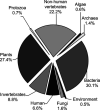NCBI viral genomes resource
- PMID: 25428358
- PMCID: PMC4383986
- DOI: 10.1093/nar/gku1207
NCBI viral genomes resource
Abstract
Recent technological innovations have ignited an explosion in virus genome sequencing that promises to fundamentally alter our understanding of viral biology and profoundly impact public health policy. Yet, any potential benefits from the billowing cloud of next generation sequence data hinge upon well implemented reference resources that facilitate the identification of sequences, aid in the assembly of sequence reads and provide reference annotation sources. The NCBI Viral Genomes Resource is a reference resource designed to bring order to this sequence shockwave and improve usability of viral sequence data. The resource can be accessed at http://www.ncbi.nlm.nih.gov/genome/viruses/ and catalogs all publicly available virus genome sequences and curates reference genome sequences. As the number of genome sequences has grown, so too have the difficulties in annotating and maintaining reference sequences. The rapid expansion of the viral sequence universe has forced a recalibration of the data model to better provide extant sequence representation and enhanced reference sequence products to serve the needs of the various viral communities. This, in turn, has placed increased emphasis on leveraging the knowledge of individual scientific communities to identify important viral sequences and develop well annotated reference virus genome sets.
Published by Oxford University Press on behalf of Nucleic Acids Research 2014. This work is written by US Government employees and is in the public domain in the US.
Figures



References
-
- Baize S., Pannetier D., Oestereich L., Rieger T., Koivogui L., Magassouba N., Soropogui B., Sow M.S., Keita S., De Clerck H., et al. Emergence of Zaire Ebola virus disease in Guinea—preliminary report. N. Engl. J. Med. 2014;371:1418–1425. - PubMed
-
- Cotten M., Watson S.J., Kellam P., Al-Rabeeah A.A., Makhdoom H.Q., Assiri A., Al-Tawfiq J.A., Alhakeem R.F., Madani H., AlRabiah F.A., et al. Transmission and evolution of the Middle East respiratory syndrome coronavirus in Saudi Arabia: a descriptive genomic study. Lancet. 2013;382:1993–2002. - PMC - PubMed
Publication types
MeSH terms
Grants and funding
LinkOut - more resources
Full Text Sources
Other Literature Sources
Molecular Biology Databases
Research Materials

